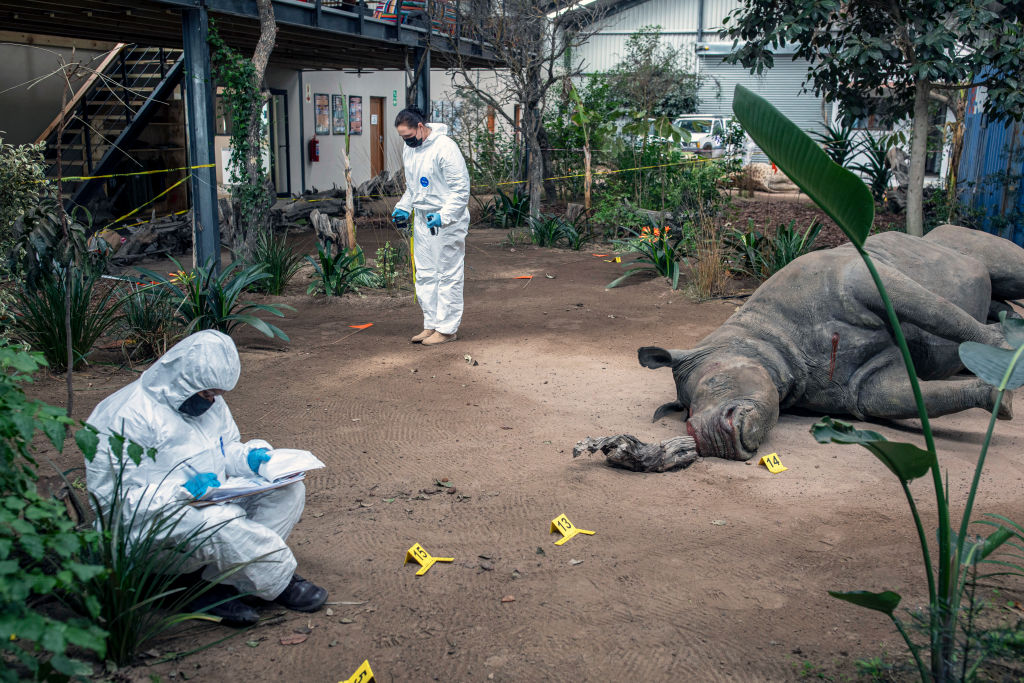Frikkie the rhino was poached and killed years ago, but today she has a new purpose at South Africa’s Wildlife Forensic Academy.
In a large, breezy warehouse inside the private Buffelsfontein Game and Nature Reserve, an hour north of Cape Town, Frikkie is one of several animals preserved by taxidermy, painted with fake blood and posed in mock crime scenes amid plants and trees.
Students wearing white hazmat suits and blue latex gloves search the grounds for clues as trainers teach them how to find, document and secure evidence before chemically analyzing it in an on-site laboratory.
Academy Director of Education Phil Snijman, a former government prosecutor, set up the elaborate mock scene with clues such as bullet casings, drops of blood on a nearby shrub, cotton fibers snagged in a thorn tree and several sets of footprints leading students to a poacher’s house in a corner of the warehouse.
“The first people who arrive at the crime scene are absolutely crucial,” he told Agence France-Presse. “They are the ones who will secure the crime scene. In the absence of the necessary training … that might lead to losing a lot of your available evidence.”
Academy founder Andro Vos, an expert in forensics and criminal justice, said poachers in South Africa are sentenced at a rate of just 5% due to a lack of forensic evidence.
“Wildlife crimes tend to take place in remote areas, so there are no witness statements,” he told British newspaper The Guardian. “So the forensic traces are often all you have to start a case.”
In 2010, when Vos met Greg Simpson, a veterinarian in South Africa’s Greater Kruger Park region, they hatched the idea of a school for wildlife forensics. Since opening in 2022, the academy has trained more than 500 park rangers, law enforcement officers and students to fight wildlife crime using forensic science techniques.
“People need to experience what it’s like,” Vos said. “How are you going to inspire people just sitting in a classroom with a whiteboard? That’s why we have all these realistic scenes. Attention to detail is what forensics is all about.”
South Africa, home to a large rhino population, accounts for most of the world’s rhino poaching cases, with more than 10,000 killed since 2007, according to the International Rhino Foundation. Rhino horn is prized by adherents of Traditional Chinese Medicine, despite scientific evidence showing it has no medicinal value. Experts have estimated that more than $20 billion of rhino horn is trafficked on the black market every year. It is one of many illegal wildlife commodities that are primarily sourced in Africa.
Claire Gwinnett, a professor of forensic and environmental science at the University of Staffordshire in England, works with the academy and is helping to promote her field’s potential impact on wildlife crime.
“While forensic science has proven highly effective in solving human crimes, its potential in wildlife crime remains underused,” she said in a Staffordshire news article published in January. “Advances in DNA technology, for example, allow investigators to create profiles from even a single cell, yet these techniques are rarely applied to animal-related cases.”
The academy offers one- to four-week courses that focus on forensic investigation, including processing crime scenes, analyzing trace evidence, searching property and vehicles for evidence of poaching, determining cause and manner of death, and navigating legal proceedings.
The programs culminate in a mock courtroom where students present their findings and undergo cross-examination. In 2023, only 36 cases were convicted in South Africa’s courts, according to government figures.
Gwinnett said the academy’s comprehensive approach aims to increase successful prosecutions and deter future crimes.
“By building a network of trained professionals, the academy hopes to create a united front against poaching and wildlife trafficking,” she said. “As these efforts gain momentum, the hope is that more animals will be spared from illegal hunting and trafficking, securing a future where wildlife can thrive free from exploitation.”

